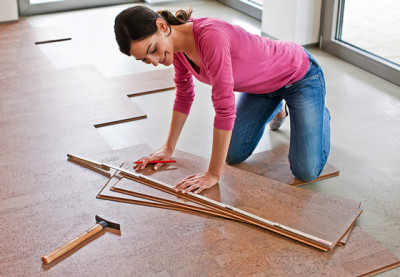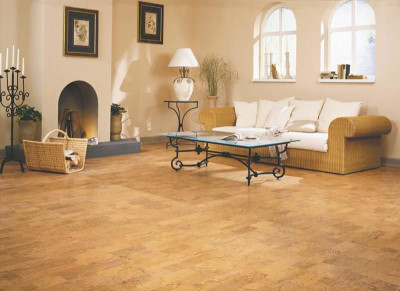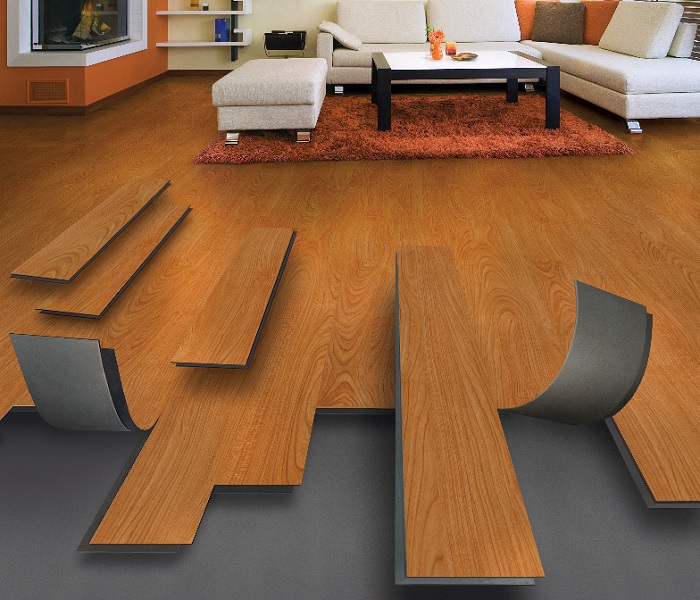Cork laminate: an overview of the features of the coating and a guide to its installation
Cork floors are gradually moving from the category of exotic to the familiar niche of popular flooring. And this is entirely predictable! The floor from the cork is always warm and soft, it traps noises, dust does not accumulate on it and dishes do not break. The only drawback that limits its widespread use is the high cost of cork oak veneer, from which fragments a cork is made. However, manufacturers have found a brilliant simplicity in their way out of this situation. To reduce the price of coating, they began to produce cork laminate (otherwise - cork flooring) - a symbiosis of cork and particleboard (or MDF). Keeping all the properties of an integral cork, this coating has a more affordable price and, in addition, is very easy to fit.
What kind of coverage is this?
Cork laminate, as well as ordinary, is sold in the form of elongated slats with a locking fastening system. Each bar consists of several layers:
- 1st layer (bottom) - natural cork (made from pressed crumbs);
- 2nd layer - fiberboard or MDF;
- 3rd layer - natural cork;
- 4th layer - veneer of cork oak or other tree species;
- 5th layer - varnish or vinyl protective coating.

Cork laminate panels are connected into a common coating by a “floating”, glueless method. Due to the spikes and grooves located on the ends, the dies are combined with each other "into the castle", without being fixed on the base. “Floating” laying is very simple, does not require building skills and, in addition, makes the cork floor very repairable. That is, if one or several panels are damaged, you can easily replace them with new ones without opening the entire floor. The coating is quite strong in structure and in operation resembles parquet or laminate.
Step-by-step laying of cork laminate
Installation of cork "floating" floors is simple and is carried out in several stages:
1. Adaptation of cork laminate to room temperature and humidity. To do this, the cork laminate introduced into the house must be left in the package to “rest” for 48 hours. During this time, the material adapts to the climate of the room and takes its final size (it may expand if the humidity is higher than in the store or, on the contrary, dries and shrinks).
2. Leveling the base of the floor. A “floating” cork-based laminate forgives some unevenness in the substrate, but it is still advisable to have fewer errors. Therefore, the old, worn-out coating is dismantled and the rough floor is leveled with cement screeds or self-leveling mixtures. It is necessary to achieve that the foundation for laying becomes smooth, clean, hard and smooth.
An impeccable subfloor is the main condition for long-term impeccable service of a laminate laid on top of it. You will learn in detail about the various options for leveling the floor plane from the material:https://floor.techinfus.com/en/pol-pokritiya/laminat/kak-vyrovnyat-pol-pod-laminat.html.
3. Mounting the substrate. A cork laminate substrate is optional. It is needed if moisture will accumulate on the base during operation. For example, when laying cork in the bathroom or on the first floor, below which is a damp basement. The effect of moisture on the cork laminate is undesirable, as it leads to deformation of the coating.As a result, noticeable gaps occur between the joints of cork panels.
As a vapor barrier, polyethylene can be used. It spreads to the base base with a lap on the walls (3-4 cm). Cloth films overlap, all joints are glued with tape. A technical cork or polypropylene substrate is often laid on top of polyethylene, but they are used only for additional heat and sound insulation, as well as for leveling the remaining defects (roughnesses) of the base.
4. Assembly of cork panels in a "floating" way. The installation principle is the same as with a conventional laminate. Cork panels begin to stack in rows, starting from the far corner of the room. The seams of the previous and subsequent rows are shifted by a third or half of the panel to get a “chess” pattern. The assembly of the floor is as follows: in the groove of the already installed panel, the spike of the next board is placed at an angle, press on it and carefully lowered into a horizontal position. The thorn-groove lock is latched. Next, a wooden block is laid on the end of the laid panel, it is hit several times with a hammer - to seal the joints. Thus mounted row by row.

When laying, remember that between the walls and cork, as well as around any obstacles (pipes, sills, etc.), compensation gaps of a couple of centimeters should remain. Over time, the cork-coated laminate will necessarily expand and, if the width of these gaps is insufficient, it will rest against the walls and swell, warp.
5. Mounting skirting boards. The deformation gaps that remain after laying the cork coating are covered with skirting boards. The most effective in this case is to use products made of the same cork as the main coating. Although wooden or laminated skirting boards (from MDF) are also good. In order to fix cork skirtings on the walls, mounting glue is used, wooden or laminated products are mounted using special clips, screws, dowels, nails. The selected type of skirting board is mounted on the wall so that it hangs over the floor at a distance of 1-2 mm.
We will tell you how to choose a wooden plinth from an array and install it yourself, in an article on our website:https://floor.techinfus.com/en/pol-pokritiya/plintus/derevyannyj-plintus-iz-massiva.html.

The floor from the cork laminate (cork flooring) is ready! On it you can immediately walk, arrange furniture and operate in full force.
A flexible laminate in its appearance almost does not differ from a conventional one, but is characterized by special flexibility, wear resistance and ease of installation. We will tell about this material, installation methods and requirements for the foundation, in a special article:https://floor.techinfus.com/en/pol-pokritiya/laminat/gibkij-laminat.html.
The advantages of this material
To summarize the above, we will appreciate the real benefits of cork laminate. Why is it so attractive to potential buyers? Here are just the main of its advantages:
- high maintainability. The floor can be assembled and disassembled 2-3 times without loss of quality and decorative appearance;
- quick and easy installation;
- warm surface;
- soundproof properties;
- softness and elasticity, allowing to reduce the load on the joints and spine when walking;
- Compared to solid cork, lower cost.
That's it for today, ladies and gentlemen. If you have any questions or comments - write!




4 comments